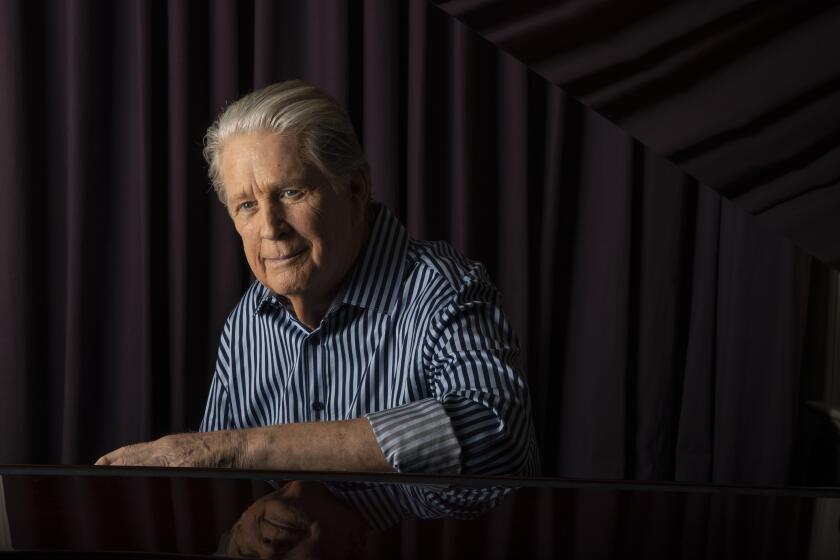Going back to the future, one movement at a time
- Share via
Although Thierry Malandain makes dances as idiosyncratic -- indeed, even eccentric -- as other French modernists, he’s chosen dance history as his personal playground. So his accomplished, alluring Ballet Biarritz, which performed Friday as part of the UCLA Live series, was a simultaneous vision of past and present -- and maybe the future as well.
Back in France, the repertory includes Malandain’s witty versions of one-act classics from the Diaghilev Ballets Russes and a full-evening creation that fuses the history of Western theatrical dance with biblical stories. At Royce Hall, he offered American premieres of his distinctive takes on two enduring scores for long lost ballets: Mozart’s plotless “Les Petits Riens” from 1778 and Gluck’s dance drama “Don Juan” from 1761.
There are few choreographers anywhere who match Malandain’s obvious sense of delight in finding amusing things for his dancers to do and wear -- and in playing ingenious theater games with the audience. “Les Petits Riens” teased the viewer with constant slumping, angular or contorted anti-classical moves that suddenly, seamlessly blossomed into examples of pristine balletic purity.
Malandain also used stage space with the freedom of a film director who can move his camera anywhere: This divertissement began with the audience supposedly backstage, behind the curtain, watching the dancers warming up (and giving us previews of choreographic motifs). We then saw the dancing from our normal perspective -- with, however, the dancers clad in designer Jorge Gallardo’s evocations of 18th century underwear or practice clothes. In the finale, we suddenly found ourselves at the rear of the stage as dancers in extravagant period costumes took curtain calls facing away from us.
Assigned major solos and duets, Silvia Magalhaes and Roberto Forleo excelled in what might be called the star roles. But a trio showcasing Cedric Godefroid, Veronique Aniorte and Mikel Irurzun del Castillo -- and a duet for Camille Auble and Miguel Pla Boluda -- also displayed exemplary technical skill, versatility and individuality.
Midway through, Malandain introduced scenic units depicting clumps of brush behind which the dancers could disappear for various romantic or farcical liaisons. There was even a ballet flasher: a dancer in a period coat who looked like a boy but unveiled bare breasts long enough to prove otherwise.
If you consider this kind of action an outrageous imposition on the music, do your homework: Like Malandain’s references to Cupid, this cross-dressing and unveiling scene came straight from the original 1778 synopsis. The title “Les Petits Riens” translates as “The Little Nothings” (or “Bits of Nothing”), and Malandain made his treatment disarmingly irreverent, impulsive and effervescent.
In “Don Juan,” all the company men cross-dressed, helping form a large women’s corps that initially mourned the title character, then (after he turned out to be alive) took turns wooing him and ultimately flapped long skirts like the flames of hell as he went to his doom.
The action swirled around, under and atop a long table that split into triangular segments, rearranged by the dancers. Godefroid, Castillo and Frederik Deberdt alternated and sometimes overlapped as the predatory Don, with the role of the victimized Elvira also assigned to three dancers: Magalhaes, Aniorte and Magali Praud.
Unfortunately, all the fizzy distractions -- the frequent casting switcheroos, the endlessly fragmenting and coalescing table sections, Forleo’s energy as a drag comic foil -- proved no more successful than Malandain’s choreographic talent and his leads’ interpretive skills in minimizing the essential problem with this “Don Juan”: its score.
Whatever Gluck’s music represents in ballet history, it sounded impossibly undramatic to modern ears -- too light and formal to support a tale of seduction, murder and supernatural revenge except in a very few passages (most notably the finale). Indeed, Malandain might have realized his expressive purposes more persuasively if he’d used Gluck for his bits-of-nothing entertainment and an orchestral suite from Mozart’s “Don Giovanni” for this story ballet.
Even in defeat, however, he managed to impress by layering classical ballet, modern dance and contemporary physical theater in an exciting, original, holistic style that just might be the theater-dance of the future.
Malandain obviously understands the lessons that dance history teaches about the evolution of movement expression. His “Don Juan” may be too obsessed with its own cleverness and too undermined by its vintage accompaniment to represent a major creative breakthrough. But the way it marshals and combines its movement resources points the way toward something the whole art has been searching for.
More to Read
The biggest entertainment stories
Get our big stories about Hollywood, film, television, music, arts, culture and more right in your inbox as soon as they publish.
You may occasionally receive promotional content from the Los Angeles Times.










